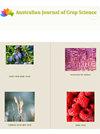Spatial distribution of acidity components and oxidizable carbon fractions in a silvopastoral system
Q3 Agricultural and Biological Sciences
引用次数: 0
Abstract
The silvopastoral system (SPS) stands out as an agroecological production system that has improved the soil's chemical quality. However, these chemical properties may have distinct changes with greater or lesser distances from the tree row tracks of the silvopastoral system. The objective of this study was to investigate the effects of the distance of the soil sampling points from the eucalyptus tree rows in a 2-year silvopastoral system on acidity components and oxidizable organic carbon fractions of the soil, as well as to compare these chemical properties with the conventional pasture system and native Cerrado vegetation. In the silvopastoral system (SPS), the soil samples were collected at 2.5, 5.0, 7.5, and 10 m of transverse distance from the eucalyptus tree row tracks. Soil samples collected in a conventional pasture area (CP) and a native Cerrado vegetation area (NV) were used as reference treatments. Soil samples were collected at depths from 0.0–0.10, 0.10–0.20, and 0.20–0.30 m. The acidity components (pH, Al3+ and H + Al) and oxidizable organic C fractions (F1: labile fraction; F2: moderately labile fraction; and F3: poorly labile fraction) were determined. The results showed that the lowest soil acidity level was observed at 2.5 and 10.0 m distances from the eucalyptus tree rows. However, the spatial distribution of soil sampling points to the eucalyptus tree rows in a 2-year silvopastoral system did not change the oxidizable fractions of the soil organic carbon. The 2-year silvopastoral system and native Cerrado vegetation area had the highest concentrations of organic carbon in the labile (F1) and poorly labile (F3) fractions in the soil profile compared to the conventional pasture system. A 2-year silvopastoral system in a low fertility tropical soil from the Brazilian Cerrado has not yet been able to improve the soil's chemical quality; therefore, further research should be carried out to investigate the medium and long-term effects of the silvopastoral system on the acidity components and oxidizable organic carbon fractions of the soil.森林生态系统酸性组分和可氧化碳组分的空间分布
森林生态系统(SPS)作为一种改善土壤化学质量的农业生态生产系统而引人注目。然而,这些化学性质可能有明显的变化,与林栖系统的树行轨迹或大或小的距离。本研究的目的是研究2年森林放牧系统中桉树行土壤采样点距离对土壤酸性成分和可氧化有机碳组分的影响,并将这些化学性质与传统牧场系统和塞拉多原生植被进行比较。在林栖系统(SPS)中,分别在距桉树行径2.5、5.0、7.5和10 m横向距离处采集土壤样品。以传统牧区(CP)和塞拉多原生植被区(NV)的土壤样品作为对照处理。土壤样品采集深度分别为0.0-0.10、0.10-0.20和0.20-0.30 m。酸性组分(pH、Al3+和H + Al)和可氧化有机C组分(F1:不稳定组分;F2:中等不稳定馏分;F3:不稳定分数)。结果表明,距桉树行2.5 m和10.0 m处土壤酸度最低;然而,在2年造林系统中,土壤采样点在桉树行内的空间分布并没有改变土壤有机碳的可氧化组分。与传统放牧系统相比,2年森林放牧系统和塞拉多原生植被区土壤剖面中不稳定(F1)和不稳定(F3)组分的有机碳浓度最高。在巴西塞拉多(Cerrado)低肥力的热带土壤中进行了2年的银稻系统,但尚未能够改善土壤的化学质量;因此,应进一步研究森林生态系统对土壤酸性组分和可氧化有机碳组分的中长期影响。
本文章由计算机程序翻译,如有差异,请以英文原文为准。
求助全文
约1分钟内获得全文
求助全文
来源期刊

Australian Journal of Crop Science
农林科学-农艺学
CiteScore
1.20
自引率
0.00%
发文量
75
审稿时长
3.5 months
期刊介绍:
Information not localized
 求助内容:
求助内容: 应助结果提醒方式:
应助结果提醒方式:


